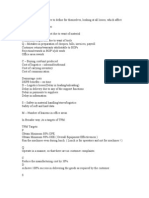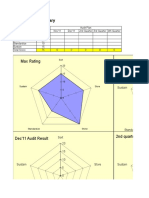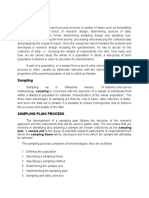CANDO Pillar Audit Check Sheet
CANDO Pillar Audit Check Sheet
Uploaded by
harpreetmuditCopyright:
Available Formats
CANDO Pillar Audit Check Sheet
CANDO Pillar Audit Check Sheet
Uploaded by
harpreetmuditCopyright
Available Formats
Share this document
Did you find this document useful?
Is this content inappropriate?
Copyright:
Available Formats
CANDO Pillar Audit Check Sheet
CANDO Pillar Audit Check Sheet
Uploaded by
harpreetmuditCopyright:
Available Formats
CANDO Pillar Audit Checklist
# Review Point 1 CANDO Structure Score Scoring Guideline 1 There is a formal structure & team laid down along with a CANDO board for the zone, with standard displays to be put on it - clearly identified 2 There is photograph displayed of the CANDO team along with the leader 3 Display of the team structure along with the skill level and brief profle of each team member 4 The CANDO structure displayed also lists down responsibility of each team member 5 Displayed CANDO team & responsibilities list is updated with - completeness of the responsibility along with dates 1 CANDO Pillar goals are set at broad plant level only and not communicated to the individual CANDO zones 2 There is tracking mechanism in place for goal achievement of each CANDO zone in the plant 3 Goals are set upto team & individual level and there is regular review of goals alongwith action plans for gap 4 CANDO team leaders conduct regular performance reviews, solicit input from the team on performance issues and identify action plans. 5 CANDO zone has been faring well (scoring more than 50% in CANDO audits conducted by Plant) and adhering to responsibilities regularly - reflecting in the CANDO audits conducted by Plant CANDO / ME Coordinators 1 All existing & potential leakage points have been identified, listed & displayed with date of identification mentioned and system is in place to track them regularly 2 Leakage and spillage points have been prioritized for the purpose of removal based on criticality 3 Root cause analysis of HTA (Hard To Access) & SOC (Source of Contamination) is initiated and over 20% of the cases of leakage, spillage, HTA & SOC points have been addressed and removed permanently using POKA YOKE (Mistake Proofing) measures etc. 4 Over 50% of the cases of leakage, spillage, HTA & SOC points have been addressed and removed permanently using POKA YOKE (Mistake Proofing) measures etc. 5 4 Problem solving (with the help of SD pillar) 1 2 3 There is clear visual identification/marking for such points and frequency of reviewing / inspecting defined through colour coding, symbols etc. CANDO team prepares a problem bank (including both existing & potential problems) on a monthly basis CANDO Leader identifies need for training and relevant topics for each CANDO member on a quarterly basis and ensures registering such requirements with the plant CANDO / ME Coordinators Over 60% of CANDO members have been trained on problem solving tools like LEAN for identification and elimination of wastes like MUDA (Wasteful activities), MURA (Inconsistency) & MURI (Physical Strain), 5-S, Differential Diagnosis, Autonomous Maintenance (AM), why-why analysis, Fishbone analysis etc. Training application on shop floor in the form of Kaizen / improvement project, validated by plant CANDO / ME Coordinator by atleast 50% of the trained members Training effectiveness is evident through 80% of problems being resolved (to be evaluated by CANDO leaders & Plant CANDO/ME coordinators) The scoring criteria is as follows Critical equipment benchmarks and standards laid down (min % of critical equipments covered) 1 2 3 4 5 1 2 Operator & asset care point training for critical equipments provided to operators (min % of critical equipments covered) Criteria - Evident teamwork and up to date display of the activities and progress of the CANDO zone Positive points Areas of Improvement Score
2 CANDO Pillar Goals (Strategic Planning, Goal Setting & Benchmarking)
- No. of internal reviews of goal achievement - On questioning, CANDO team member should be able to tell their respective goals, gaps and means to achieve
3 HK (House Keeping) & CANDO activities
- No. of cases found and addressed (can be registered as Kaizen if CAPA done) - Tidy looking Leak-free, Spillage-free, HTA & SOC free CANDO zones - Possibly reduction in housekeeping staff
4 5 5 Operator Asset care (with the help of SD pillar)
In last 3 months - No. of trainings undergone by each CANDO member (to be displayed on CANDO Board) - No. of Kaizen contributed by CANDO zone - % of problems resolved out of those listed in problem bank
6 Man-Machine allocation (Structure & Manning)
20% 20% 30% 30% 50% 50% 75% 75% 100% 100% Allocation of area & machine for the implementation of my/ our area, machine has been initiated for critical equipments. Fresh list of critical equipment as on 1/4/2010 to be referred Area & machine allocation has been completed for 20% of critical equipments along with SOPs/Guidelines displayed enabling operators to address minor stoppages or breakdowns along or call the right person for solving, depending on the level of problem Area & machine allocation has been completed for 30% of critical equipments along with SOPs/Guidelines displayed enabling operators to address minor stoppages or breakdowns along or call the right person for solving, depending on the level of problem Area & machine allocation has been completed for 50% of critical equipments along with SOPs/Guidelines displayed enabling operators to address minor stoppages or breakdowns along or call the right person for solving, depending on the level of problem. Fairly good level of visual control Area & machine allocation has been completed for 75% of critical equipments along with SOPs/Guidelines displayed enabling operators to address minor stoppages or breakdowns along or call the right person for solving, depending on the level of problem. High level of visual control applied by the CANDO member on/in his machine/area
Benchmarking has been done and equipment performance has been measured against: 1: Design performance 2: Outside performance 3: Industry performance 4: KNPL performance 5: My own best performance
- Increase in MTBF - % of cases where equipment failures were addressed by operator himself - Decreasing trend in MTTR (Excluding outliers) - Sufficient updated visual control near the allocated area
7 CANDO Zones covered under AETs towards zero breakdown (AET wise tracking)
5 8 Safety, Health & Hygiene (with the help of SD pillar) 1
2 3
4 5
9 Daily Management through CANDO
There are at least 20% critical equipments in the CANDO zone with 50 % reduction in no.of notifications in last 3 months & standard display on each equipment giving no. of days passed without any breakdown to be more than 30 days There are at least 30% critical equipments in the CANDO zone with 50 % reduction in no.of notifications in last 3 months & standard display on each equipment giving no. of days passed without any breakdown to be more than 45 days There are at least 50% critical equipments in the CANDO zone with 50 % reduction in no.of notifications in last 3 months & standard display on each equipment giving no. of days passed without any breakdown to be more than 60 days There are at least 75% critical equipments in the CANDO zone with 50 % reduction in no.of notifications in last 3 months & standard display on each equipment giving no. of days passed without any breakdown to be more than 75 days There is regular tracking of breakdowns for each equipment in the CANDO zone - status to be displayed on CANDO Board Formal training is initiated for CANDO members to explain safety behavior expectations and make them aware of health & hygiene issues and a formal system has been developed for the tracking of accidents, incident & nearmisses 50% of CANDO members have been given essential training on Safety, Health & hygiene (PPE, MSDS, Safe working norms, Raw material compatability etc.) All CANDO members have been given training on above mentioned aspects of Safety. Material is stored as per RM Compatability list. There is regular analysis and Corrective actions undertaken to address accidents, incident, Minor Injuries & nearmisses CANDO members are aware of the safety norms & practices and safety mechanisms provided by design and ensure they are intact for all equipments in use including MHEs etc. There are interlocks & fool proof mechanisms provided for prevention of accidents, incident, Minor Injuries & nearmisses. Such initiatives may be classified as Kaizen (subject to Kaizen coordinator's approval) Self audits by CANDO team CANDO members take decisions CANDO members are involved in members is conducted as for removal of A (green tag) & B problem analysis & prevention per the defined schedule (red tag) type abnormalities & (Ideally Monthly - using this are involved in removal of audit sheet upto point 10) abnormalities (from Autonomous Maintenance Training) Know-your-machine training Standards are implemented for CANDO members regularly and for key target groups has all equipments & equipments are effectiely participate in Kaizen in all been completed as per the standards CANDO Zones Visual controls for inventory Review , update of CLTI check norms list (as fallout of any BD maint, Kaizen , FIP done) Visual displays for preventive & breakdown maintenance
- Reduction in No. of notifications - Reduction in no. of breakdowns
- Reduction in no. of incidents/accidents/MI/near misses - Increase in no. of Safety kaizen from CANDO zones - Awareness among operators about use of PPE and other safety aspects (Operators to be questioned) - Compliance in use of PPE to be seen on shop floor
10 Over all Cleanliness, orderliness and asthetics of the facility
1 2 3 4 5 1 2 3 4
At least 1 element is implemented At least 2 elements are implemented At least 4 elements are implemented At least 6 elements are implemented At least 8 elements are implemented Abnormality register, list of HTA and possible Leakage /spillage points are available in all CANDO Zones and the same is visible on the shop floor Implementation of at least first 2 levels of 5-S (i.e. 1-S, 2-S) is evident through floor markings, search- Visual markings on shop free working etc. Standard search time allowed world over is 30 seconds. 3rd level (3-S) has been implemented and CANDO member incharge ensures aethetical appeal and not floor - Search-free working only clean equipments and floor but also usability and basic condition is restored There is no "NO MAN'S LAND". 5-S, Overall cleanliness and orderliness in the CANDO zones ,which does - Neat & tidy work area not fall under any AET are Visible. Also, other equipments like MHEs etc. are included. Point no. 1, 2 & - Clean equipments - No unwanted items seen 3 are also addressed effectively in these areas All the above points have been monitored & audited by plant CANDO Coordinators every month for 3 months (substantiated by comments by external auditors , HO members, Photographs sent to Corp ME Cell ) 25% of CANDO zones are at level 2 50% of CANDO zones are at level 2 75% of CANDO zones are at level 2 90% of CANDO zones are at level 2 All CANDO Zones are at level 2
11 CANDO team scores
1 2 3 4 5
You might also like
- Minimizing The Eighth Waste of Lean-Absenteeism Through Six Sigma MethodologyDocument6 pagesMinimizing The Eighth Waste of Lean-Absenteeism Through Six Sigma MethodologyAshraf AliNo ratings yet
- CAses SOlution MalhotraDocument60 pagesCAses SOlution MalhotramanzakNo ratings yet
- Sample Research Report: Executive Summary (Summary or Abstract)Document2 pagesSample Research Report: Executive Summary (Summary or Abstract)Mr. Yogesh Ramani80% (5)
- 7 Equip Loss Def. by JIPMSDocument5 pages7 Equip Loss Def. by JIPMSRanjit BhandariNo ratings yet
- 16 Types of Loss in GembaDocument5 pages16 Types of Loss in GembashivendrakumarNo ratings yet
- Activity BoardDocument3 pagesActivity BoardluxgmNo ratings yet
- Quality NewsletterDocument35 pagesQuality NewsletterMOHANNo ratings yet
- Shipping LevelDocument5 pagesShipping LevelSudhagarNo ratings yet
- Supplier Rating System: Quality (35 Points)Document2 pagesSupplier Rating System: Quality (35 Points)QSSD ENTERPRISESNo ratings yet
- 5S Guidence PDFDocument28 pages5S Guidence PDFAnonymous llBSa7No ratings yet
- Submitted By,: Jarzid Alam Alomgir Badsha Saif MahabubDocument26 pagesSubmitted By,: Jarzid Alam Alomgir Badsha Saif MahabubSaif KhanNo ratings yet
- Question BankDocument16 pagesQuestion BankAman SinghNo ratings yet
- Chapter 9. Failure Root Cause PreventionDocument23 pagesChapter 9. Failure Root Cause PreventionAbdirahman Ali mohamudNo ratings yet
- Waste EliminationDocument31 pagesWaste Eliminationaarun01No ratings yet
- PQCDSM KPI Definitions - Continuously Improving ManufacturingDocument13 pagesPQCDSM KPI Definitions - Continuously Improving ManufacturinggcldesignNo ratings yet
- TRG 5SDocument28 pagesTRG 5SRajaIshfaqHussainNo ratings yet
- A Kanban Milk-Run Coordinated Milk-Run ApplicationDocument14 pagesA Kanban Milk-Run Coordinated Milk-Run ApplicationZeynep AykulNo ratings yet
- 16 LossesDocument2 pages16 LossesShekhar9No ratings yet
- Guidelines - Manuals For Consulting Services To Auto-Parts SuppliersDocument296 pagesGuidelines - Manuals For Consulting Services To Auto-Parts SuppliersAhsan RiazNo ratings yet
- Ojt Format All-Hcasf008Document34 pagesOjt Format All-Hcasf008Utpal YadulNo ratings yet
- Presentation On House Keeping TechniquesDocument82 pagesPresentation On House Keeping TechniquesJanak DoshiNo ratings yet
- 5s Training Module by Jayanth, Feb 09Document82 pages5s Training Module by Jayanth, Feb 09Senyum Sehat100% (1)
- Work Study, Time StudyDocument21 pagesWork Study, Time StudyShashank SrivastavaNo ratings yet
- 5S Thoughts - AllDocument12 pages5S Thoughts - Allssk3712No ratings yet
- Breakdown RagisterDocument1 pageBreakdown RagisterJayant MistriNo ratings yet
- Set-Up Observation Analysis SheetDocument2 pagesSet-Up Observation Analysis SheetBalaji SNo ratings yet
- PQCDSMDocument2 pagesPQCDSMSam SiewNo ratings yet
- Chapter Five: Project Planning FundamentalsDocument29 pagesChapter Five: Project Planning Fundamentalsgeachew mihiretuNo ratings yet
- Ind Eng'g Annual ConferenceDocument43 pagesInd Eng'g Annual ConferenceProf Daniel KitawNo ratings yet
- TAKT Time Mixed ModelDocument113 pagesTAKT Time Mixed Modelsitam_nitj4202No ratings yet
- Meta Abo FinalDocument89 pagesMeta Abo FinalMuluken TemesgenNo ratings yet
- TPM PoliciesDocument2 pagesTPM PoliciesBalaji S100% (1)
- Systems and Quality Day2Document86 pagesSystems and Quality Day2Prof Daniel KitawNo ratings yet
- Autonomous Maintenance (AM) ChecklistDocument60 pagesAutonomous Maintenance (AM) ChecklistChasiwa OmphemetseNo ratings yet
- Sona GroupDocument56 pagesSona GroupbrindatammaNo ratings yet
- CHAPTER 03 - MIS As Business Management FunctionDocument61 pagesCHAPTER 03 - MIS As Business Management FunctionMrz RostanNo ratings yet
- MPPDocument5 pagesMPPalokbdasNo ratings yet
- 5S and Visual Management: Krishna HedaDocument78 pages5S and Visual Management: Krishna HedaLong TưNo ratings yet
- TPM Wabco-Tvs (India) LTDDocument46 pagesTPM Wabco-Tvs (India) LTDpnithiy_elecNo ratings yet
- ZED PresentationDocument13 pagesZED PresentationSatbir SinghNo ratings yet
- Chapter 10. Initial Flow Control ManualDocument10 pagesChapter 10. Initial Flow Control ManualVivek KumarNo ratings yet
- Set-Up Observation Analysis Sheet: TotalsDocument23 pagesSet-Up Observation Analysis Sheet: TotalsKhaled KassemNo ratings yet
- Chapter 5 Measure - GBDocument134 pagesChapter 5 Measure - GBKaranShindeNo ratings yet
- Level III Improving Business PracticeDocument18 pagesLevel III Improving Business PracticeHabteNo ratings yet
- Audit ChecklistDocument12 pagesAudit Checklistjohnoo7No ratings yet
- PMAR Back To Basics Pt1Document13 pagesPMAR Back To Basics Pt1Hero VinothNo ratings yet
- COPQ TrackerDocument2 pagesCOPQ Trackergopalranjan_2000939No ratings yet
- TQM - Continuous Process ImprovementDocument23 pagesTQM - Continuous Process ImprovementRandeep SinghNo ratings yet
- Identifying and Removing Process Waste: Defects Overproduction Waiting Non-Utilized Staff TalentDocument2 pagesIdentifying and Removing Process Waste: Defects Overproduction Waiting Non-Utilized Staff TalenthoffspringNo ratings yet
- 5S - Levels of ExcellenceDocument2 pages5S - Levels of ExcellenceRamanagiri BharathanNo ratings yet
- 6'S Audit Sheet: Step S.No Item Rating (0-5) Comments 5 4 3 2 1Document5 pages6'S Audit Sheet: Step S.No Item Rating (0-5) Comments 5 4 3 2 1stylish eagleNo ratings yet
- Systems and Quality ElectromechanicalRDocument69 pagesSystems and Quality ElectromechanicalRProf Daniel KitawNo ratings yet
- Equipment Name Theme Division TPM Pillar Pilllar Step Basic Work Minor Classification Classification No: Major ClassificationDocument1 pageEquipment Name Theme Division TPM Pillar Pilllar Step Basic Work Minor Classification Classification No: Major ClassificationGiö GdlNo ratings yet
- Improve Productivity, Quality, Safety, Moral of Workforce Along With Reduce Cost & Response Time WithDocument66 pagesImprove Productivity, Quality, Safety, Moral of Workforce Along With Reduce Cost & Response Time Withrasheedshaikh2003No ratings yet
- Quality Costs 1Document47 pagesQuality Costs 1ramakanta_mishraNo ratings yet
- 5 S Poster LargeDocument1 page5 S Poster LargeShashi DharaNo ratings yet
- Topic 8 Team DynamicsDocument15 pagesTopic 8 Team DynamicsSHI QI LEENo ratings yet
- 5S (Practice of Good Housekeepin)Document64 pages5S (Practice of Good Housekeepin)Karen QuingNo ratings yet
- 40 Schneider Production SystemDocument55 pages40 Schneider Production Systembusiness.wiraNo ratings yet
- 9b SWIPDocument4 pages9b SWIPJose OrtegaNo ratings yet
- Sensory Characteristics of MangoesDocument7 pagesSensory Characteristics of MangoesadiNo ratings yet
- Project Report On Haldirams Mayank GuptaDocument28 pagesProject Report On Haldirams Mayank GuptaMayank Gupta100% (1)
- Italian State Museums During The COVID 19 Crisis From Onsite Closure To Online OpennessDocument12 pagesItalian State Museums During The COVID 19 Crisis From Onsite Closure To Online Opennessjoss FloresNo ratings yet
- 6 TíaDocument11 pages6 TíaAlba SanchezNo ratings yet
- Risk - Based Inspection (RBI), As A Tool For Managing Risks - Beyond Inspection PlansDocument14 pagesRisk - Based Inspection (RBI), As A Tool For Managing Risks - Beyond Inspection PlansYRNo ratings yet
- References Appendix and BibliographyDocument7 pagesReferences Appendix and BibliographyFredriech Martin Roxas100% (1)
- Lateral Load Capacity of PilesDocument9 pagesLateral Load Capacity of Pileschutton681No ratings yet
- Types of Non-Probability SamplingDocument4 pagesTypes of Non-Probability SamplingMuhammad AdeelNo ratings yet
- Welcome To All Chapters and Their Juries To Case Study Evaluation System For CCQC-2020Document11 pagesWelcome To All Chapters and Their Juries To Case Study Evaluation System For CCQC-2020Bibhudutta MishraNo ratings yet
- Assignment 1Document7 pagesAssignment 1Batman SamraNo ratings yet
- An Adaptive Thermal Comfort Model For Hot Humid SouthDocument17 pagesAn Adaptive Thermal Comfort Model For Hot Humid Southnganmt85No ratings yet
- 2017 RioDocument96 pages2017 RioPhilip PoerworahjonoNo ratings yet
- NCKH YnhiDocument37 pagesNCKH YnhiYến NhiNo ratings yet
- Chapter 1 - Introduction To StatisticsDocument91 pagesChapter 1 - Introduction To StatisticsCris Aquino PerezNo ratings yet
- PR1 FinalDocument42 pagesPR1 Finalbfpicorro5No ratings yet
- Lean Six Sigma Green Belt CurriculumDocument6 pagesLean Six Sigma Green Belt Curriculumhim2000himNo ratings yet
- Office of The Dean: Colegio San AgustinDocument12 pagesOffice of The Dean: Colegio San AgustinErichSantosValdeviesoNo ratings yet
- Hunting Heritage Action Plan: Highlights of Key Recruitment and Retention Research - 2009Document11 pagesHunting Heritage Action Plan: Highlights of Key Recruitment and Retention Research - 2009shootingcouncilNo ratings yet
- EthnographyDocument3 pagesEthnographydelavwega0405No ratings yet
- Customer-Based Brand Equity and Improvement Strategy For Mobile Phone Brands: Foreign Versus Local in The Chinese MarketDocument8 pagesCustomer-Based Brand Equity and Improvement Strategy For Mobile Phone Brands: Foreign Versus Local in The Chinese Marketharneet kaur6No ratings yet
- Notre Dame of Salaman College Inc.: Course Description: (CMO)Document2 pagesNotre Dame of Salaman College Inc.: Course Description: (CMO)Aillen Grace Azucena DayagNo ratings yet
- Financial Management Dissertation ExamplesDocument4 pagesFinancial Management Dissertation ExamplesBuyCollegePaperOnlineAtlanta100% (1)
- Activity 3 - Reflective EssayDocument1 pageActivity 3 - Reflective EssayElla CaraanNo ratings yet
- Sample Annotated BibliographyDocument12 pagesSample Annotated Bibliographyabo776No ratings yet
- Internal Assessment Criteria (Chemistry)Document5 pagesInternal Assessment Criteria (Chemistry)Chantal TockeNo ratings yet
- A Taxonomy of Manufacturing StrategiesDocument21 pagesA Taxonomy of Manufacturing StrategiesMarcos De Campos MaiaNo ratings yet
- Class Notes On SamplingDocument11 pagesClass Notes On SamplingAhel Patrick VitsuNo ratings yet
- 4 Matt PDFDocument23 pages4 Matt PDFPatricio Careaga ONo ratings yet

























































































